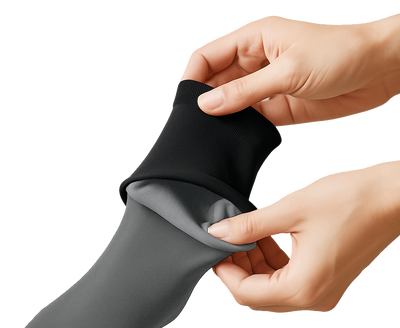COVID-19 and Diabetes: What you need to know

As our nation and the rest of the world deals with the global pandemic due to the COVID-19 Coronavirus, diabetics especially, have reason to be concerned. According to the American Diabetes Association, people with the disease have much higher rates of serious complications and even death, than those without. This affects a whopping 30-million Americans who live with the condition, including actor Tom Hanks, who already publicly suffered with a bout of COVID-19.
Data from the Centers for Disease Control (CDC) show that 37% of cases here in the U.S. had underlying health conditions, including diabetes. But, your risk of getting very sick from COVID-19 is likely to be lower, if your diabetes is well managed.
Diabetic socks are one of our top selling products, but you often ask us “What makes these different from other compression socks?” Even though diabetic socks are used by millions of people, and suggested to patients by their doctors, many of you are still not 100% sure how diabetic socks work and how they differ from regular socks. They are also helping diabetics worldwide manage their symptoms during this unprecedented time, especially due to their easy availability and accessibility in pharmacies nationwide like Walgreens, Walmart, and on MySkineez.com.
What are diabetic socks?
Diabetic socks are socks specially designed to absorb excess moisture and to keep feet dry. They are also tight, in order to stimulate healthy blood flow, and seamless, so they would prevent toe-pressure and uncomfortable squeezing.

Regular socks are often too tight around the ankle and the seam can cause pain and restrict blood circulation. Regular socks also wrinkle, and wrinkles can cause irritation and blisters, so our diabetic socks are made not to wrinkle.
What are diabetic socks made of?
Diabetic socks are mostly made of non-elastic natural material or a combination of antimicrobial materials, like acrylic, merino wool, nylon, spandex, etc.
Cotton is not considered to be a good material for this purpose because it holds moisture against the feet (causing odor and blisters), but there are other non-cotton materials to help with this problem.
Skineez’ diabetic socks are made with technical fibers that wick moisture away from the foot. This moisture then evaporates, keeping feet healthy and dry. These technical fibers also help the sock retain its shape so they don’t bag, bunch or wrinkle – the most common cause of foot ulcers.
Can anyone wear diabetic socks?
You often ask if non-diabetics can wear diabetic socks. Yes, anyone can benefit from them. They are healthy for both diabetics and non-diabetics.
Well-made diabetic socks are a healthy choice for anyone that wants a quality sock to protect their feet. The seam on regular socks often rubs on toes, causing unwanted pressure that not only irritates but may cause blistering and make it difficult to walk.
Benefits of wearing diabetic socks
The benefits of diabetic socks can be found in many aspects. For diabetics, they soothe swelling, protect from blisters, and prevent foot injuries. Seamless socks prevent irritation and infection.

Benefits of wearing Skineez diabetic socks
For non-diabetics, they provide more comfort. They keep feet warm and prevent future circulation problems, also help with excessive sweating and bad odor. Overall, they raise the quality of life for anyone.
Here are some of the benefits of wearing diabetic socks:
- With extra padding, they relieve the pressure from foot arch, heels, and ankles
- They prevent fungal and bacterial infections by keeping feet dry
- They are firmly fitted and padded, thus prevent foot injuries
- They improve blood flow with light compression
- They decrease swelling and keep feet warm
Are diabetic socks good for circulation?
Diabetic socks improve blood circulation helping those with slower blood flow to develop a healthier flow. Those suffering from diabetes fight slower blood circulation and swelling, and diabetic socks help with both. Besides many other benefits of diabetic socks, non-binding socks make restriction-free fit, so the blood can uninterruptedly circulate.
What is the difference between compression socks and diabetic socks?
The difference between compression socks and diabetic socks is in the seamlessness, the padding, the level of compression and the type of threads used to knit the socks.
Compression socks are specially designed to relieve joint pain and to help reduce swelling in the feet and legs. These socks are clinically designed to fit firmest at the ankle and lessen in pressure around the calf and top of the stocking. The compression can go from light to strong (depending on the need).
Diabetic socks have padding that lifts the pressure of toes, and they mostly have little or no seams, so the blood can freely circulate. Diabetic socks can be made from compression material, but rather from light compression, as stronger ones can be too tight for those with diabetes.
Should diabetics wear compression socks?
Light or mild compression socks can help people that suffer from diabetes by relieving foot pain, by preventing swelling, and by helping veins pump blood in a natural rhythm.
The best choice of compression socks for diabetics are graduated compression socks, which apply more pressure to the foot, and less to the calf. Compression with padding can reduce the chances of wrinkles, and shoe cuts, thus preventing the development of ulcers.
So, are compression socks good for diabetics?
Yes, they are an essential for diabetes patients, if the compression is light to mild like ours are.
Benefits of compression socks for diabetics
People fighting diabetes often develop deep vein thrombosis and venous insufficiency, both of which can be reduced by wearing compression socks.
Skineez seamless hydrating diabetic socks
As the pioneer in the wearable skincare space, Skineez is dedicated to developing high-quality medical-grade compression garments. Even though our mild compression socks can help with fighting problems caused by diabetes, we made a special seamless diabetic sock, for even more benefit and comfort.
In fact, we are THE ONLY on the market with a patented fabric to do so, made in an FDA-compliant factory. The FDA has even coded the brand as the only skin protectant fabric, providing a two-in-one savings for all utilizing health insurance savings or related accounts, to purchase this essential health and wellness necessity – a savings that is so essential to many during this COVID-19 pandemic.

Skineez seamless diabetic socks
Our seamless diabetic sock is also hydrating, meaning that the technical fibers used to make this sock, pull moisture from your feet keeping them free of sweat. These amazing socks are the first layer of protection and hydration for your feet.
The unique infusement of skin-healthy ingredients continuously deliver hydrating elements that help to soothe, prevent dry skin cracking, and irritation. In fact, in clinical studies, 80% of wearers saw softer, smoother skin, just by wearing the supple patented fabric.
Skineez’ Formula
In all of our garments, we use a 5 ingredient skincare formula that we developed and clinically studied, in a patented infused fabric carefully designed to deliver the right amount of skincare products and keep your skin safe, supple and soft.

Those ingredients are shea butter, rosehip oil, vitamin A and E, apricot kernel oil, and retinol. With our seamless hydrating diabetic socks, you will protect your skin while protecting your feet and circulatory system. That’s essentially what makes us different, from any other compression sock on the market
Our products are 100% latex-free, proudly made in the United States, and designed by professionals, such as orthopedic surgeons and skincare practitioners.



